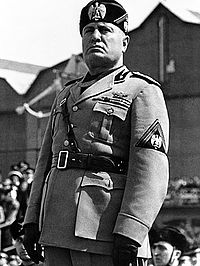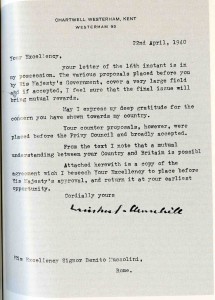Churchill-Mussolini Non-Letters
(Or: “You Haven’t Looked Hard Enough”)

“The Untold Story of Mussolini’s Fake Diaries” (Daily Beast, 12 April 2015) evaluates Mussolini’s supposed diaries, letters or documents peddled over the years, while raising some incriminating charges, or suppositions, about Winston Churchill:
Before the war, Churchill offered Il Duce a deal. After the war, British intelligence tried to destroy their correspondence…. When Churchill became prime minister in May 1940 he tried, in a series of letters, to dissuade Mussolini from joining the Axis powers. He was ignored. Three weeks later Italy joined Nazi Germany and declared war on Great Britain. Although there would have been copies in London of the Churchill-Mussolini exchanges, none has ever turned up and in April 1945, somebody in London was very anxious that Mussolini’s copies should never see the light of day.
There was no “series of letters.” Churchill himself published his only letter to Mussolini (16 May 1940), trying to persuade the Duce to stay out of the war—and Mussolini’s negative response (18 May) in 1949.1 (Incidentally, Italy joined the Axis in 1936, not 1940.)

Of course there were at least three faked letters, published in the past, and referred to by conspiracy books. One of the more recent, Il carteggio Churchill-Mussolini alla luce del processo Guareschi (2010), was exploded by reviewer Patrizio Giangreco, who illustrated the alleged Churchill letters. Complete with inauthentic letterheads and fake signatures, they are almost laughable in their amateurishness.2
The Daily Beast states that Churchill, en route to Lake Como for a painting holiday in September 1945, stopped in Milan to stand bareheaded at Mussolini’s unmarked grave. No evidence is offered, nor does it seem likely: Churchill flew from London September 2nd and arrived at Como the same day3—but I’m sure the conspiracists would claim that his vigil at Il Duce’s grave was “covered up.”
Churchill is said to have flown to Milan under the cover name “Colonel Warden,” which the Daily Beast suggests was his pilot’s name. In fact, Churchill had used “Warden” as a codename for himself and his family (“Mary Warden”) since early in the war. It likely stemmed from his 1941 appointment as Lord Warden of the Cinque Ports.4
Churchill, we are then told, arrives at his villa on Lake Como, “owned by none other than Guido Donegani…an industrialist and Fascist collaborator,” who was “interrogated by British intelligence and later released.” Churchill meets with Donegani, who apparently hands him the incriminating letters, papers or diaries—they are variously described.
The author adds that he enlisted official biographer Martin Gilbert to authenticate the diaries, letters, or whatever they were: “Gilbert, the historian, concluded that the correspondence had been retrieved and handed over to Churchill but it never turned up in the Churchill archives and was never seen again.”
This is passing strange, since Sir Martin Gilbert dismissed the idea of secret Mussolini correspondence, and nothing in his writings suggests Donegani met with Churchill. Writing to his wife the day after he arrived at Como, Churchill says the villa belonged to “one of Mussolini’s rich commercants who had fled, whither is not known.”5 (Again, the conspiracists would probably say this was a smokescreen.)
The so-called Mussolini Diaries are labeled “Fake” in the article’s title, so one must suppose there is no argument. There are a confusing number of references to various people who tried to peddle them, including one who ran away when hailed at an airport. An Interpol agent who investigated the story is quoted as saying Italians “needed people to believe that the diaries were forged” because otherwise “they would encourage a revival of the Mussolini cult and Fascism.”
How those faked 1940 letters, or other documents from 1945, would, if genuine, have revived Fascism is difficult to understand. Perhaps the best rejoinder is that of the historian Andrew Roberts:
Leaving aside the fact that Churchill would not by that stage have wanted or needed peace with Mussolini, one charge goes that the relevant documents are in a waterproof bag at the bottom of Lake Como. So, when one takes issue with them, the conspiracy theorists say, “go and look.” Of course, if you don’t find anything, they just say, “you haven’t looked hard enough.”6
Endnotes
1. Winston S. Churchill, Their Finest Hour (London: Cassell, 1949), 107-08.
2. Patrizio Giangreco, “Leading Churchill Myths: ‘Churchill Offered Peace and Security to Mussolini,’” Finest Hour 149, Winter 2010-11, pp 52-53/57. (The letters were first published in Candido in 1954.)
3. Martin Gilbert, Winston S. Churchill, vol. 7 Road to Victory 1941-1945 (Hillsdale College Press, 2013), 134.
4. Warren F. Kimball, Churchill and Roosevelt, The Complete Correspondence, 3 vols. (Princeton University Press, 1984), II 344. Lady Soames to this writer, 2005.
5. Gilbert, Road to Victory, 344, and conversations with this writer, 2010.
6. Andrew Roberts, “Churchill’s Reputation,” remarks at the Cabinet War Rooms, London, 16 November 2005.







3 thoughts on “Churchill-Mussolini Non-Letters”
Not really. Lake Como wasn’t so war ravaged. General Alexander offered him the use of a villa, and the two spent happy days painting alongside each other. The local Italians gathered and cheered him–there were no expressions of disapproval. I suppose they thought he’d helped and a war that had never been very popular among them. And he needed the break, having just received “the order of the boot” by the voters in the July general election. His daughter Sarah accompanied him, and said it did him a world of good.
Of all the paces to go on vacation why did Churchill choose a war ravaged Italy in 1945? A “painting holiday?” Seems odd.
great commentary. Of course, many people would LIKE to show Churchill as Pro-Mussolini as much as possible for political reasons. Andrew Roberts is right. The problem with conspiracy theorists is they specualate and go beyond the facts. Questionable documents are not facts.
Comments are closed.